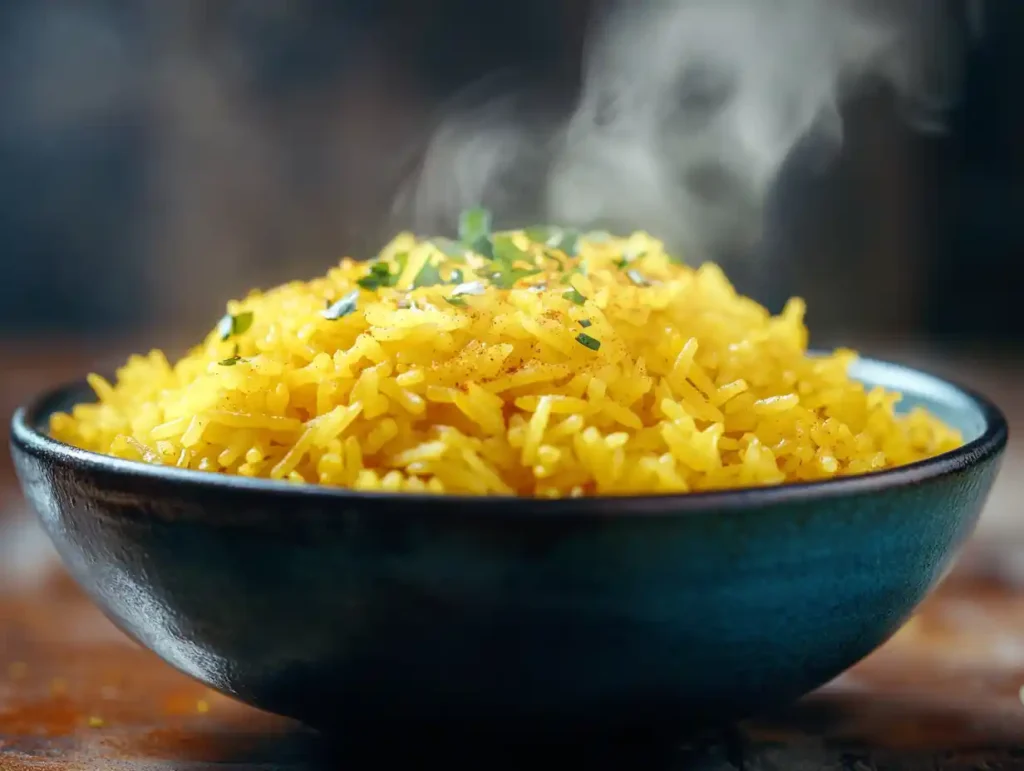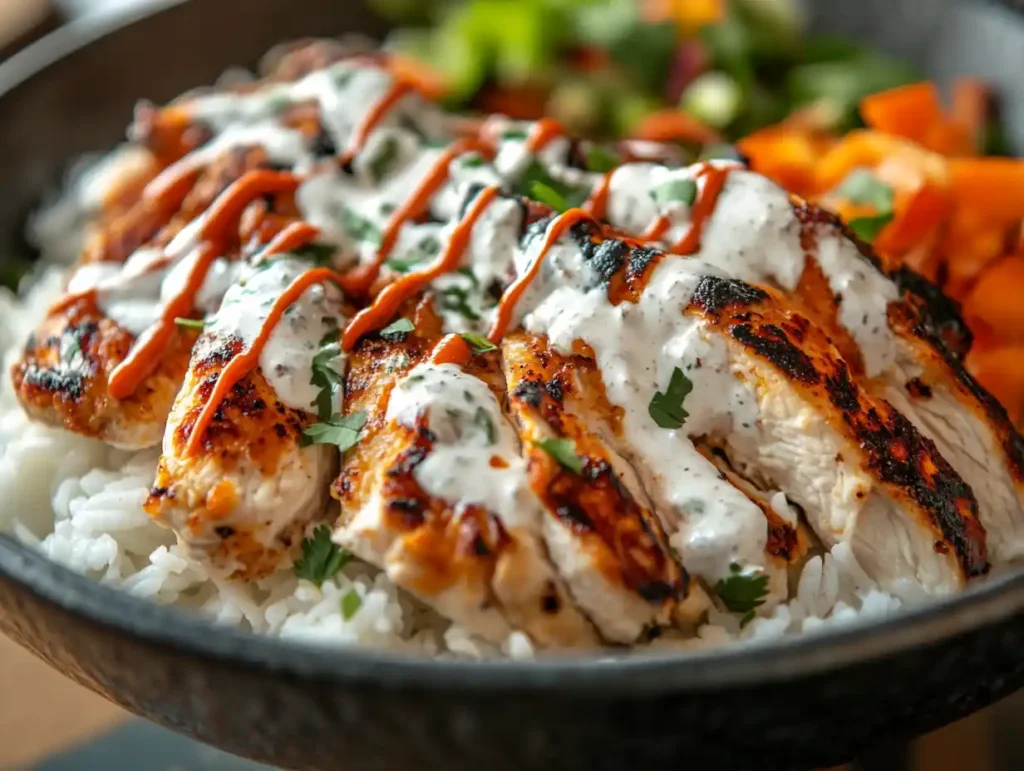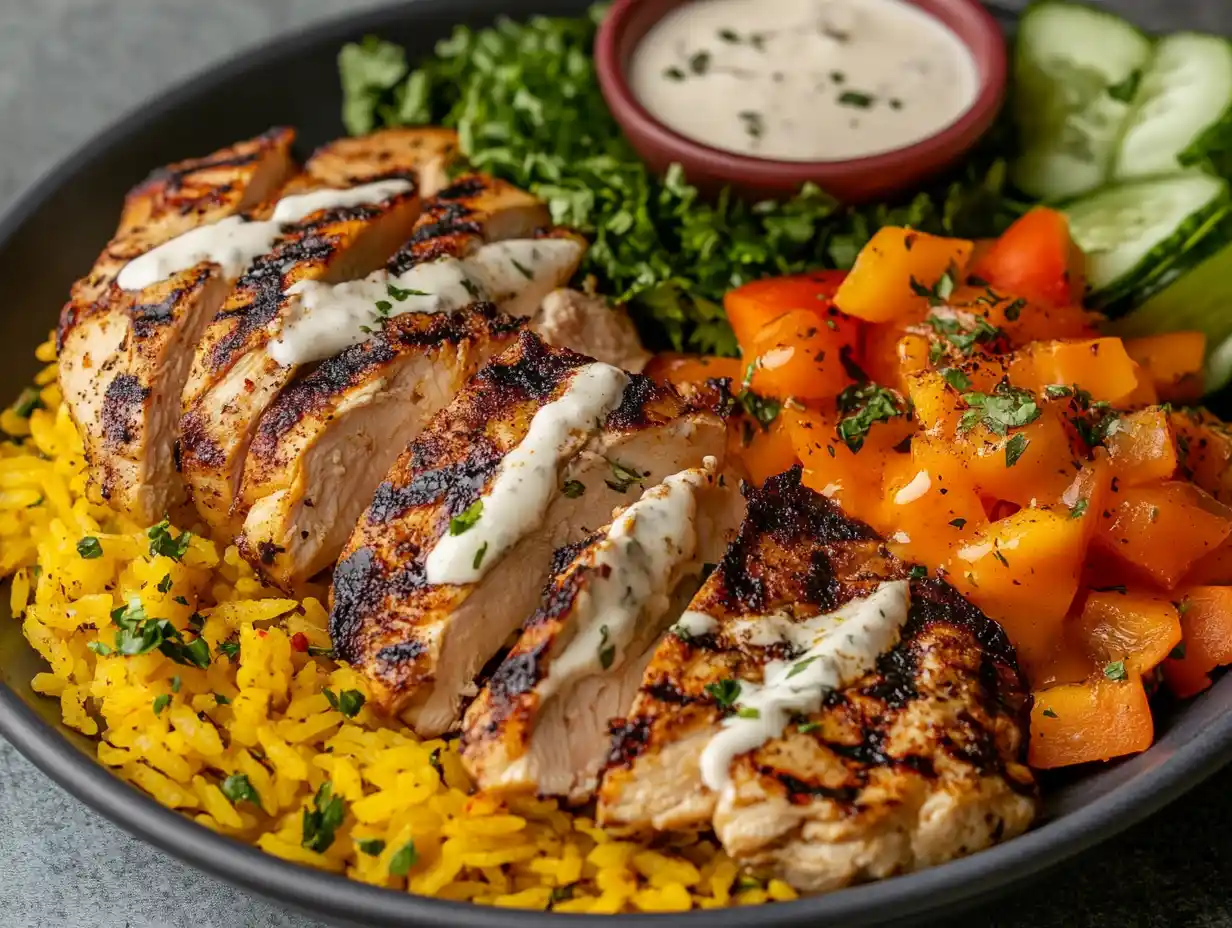Chicken over rice is a flavorful and satisfying dish that has gained global recognition, particularly as a staple of street food culture in cities like New York. Originating from a blend of Middle Eastern and Mediterranean cuisines, this dish offers a delightful mix of tender grilled chicken, aromatic rice, creamy sauces, and fresh vegetables. Its popularity stems from its convenience, affordability, and the explosion of flavors in every bite.
The meal’s essence lies in its simplicity—every component is carefully crafted to create a balanced yet indulgent dining experience. Grilled chicken provides protein, the rice serves as a hearty base, and the creamy white sauce or spicy hot sauce elevates the taste to new heights. Whether enjoyed from a food cart, restaurant, or prepared at home, chicken over rice offers something for every palate.
Main Ingredients of Chicken Over Rice
Creating chicken over rice involves combining several essential ingredients that deliver its signature taste. These components work together to create a flavorful, balanced dish loved by many.
Grilled Chicken
Grilled chicken serves as the dish’s star, offering both protein and a smoky flavor. Chefs typically marinate the chicken to enhance its taste and tenderness.
- Chicken Cuts: Many people choose boneless, skinless chicken thighs or breasts. Thighs, however, are more popular because they stay juicy and flavorful during cooking.
- Marination: A flavorful mixture of garlic, cumin, coriander, paprika, turmeric, and olive oil usually forms the marinade. This blend soaks into the meat, ensuring each bite bursts with flavor.
- Cooking Method: Chefs often grill the chicken over high heat. This process creates a slightly charred crust while locking in moisture for a tender result.
Rice Varieties
The rice acts as the foundation of the dish, complementing the chicken and soaking up the rich sauces. Its preparation significantly influences the overall experience.
- Common Rice Types: Long-grain basmati rice remains the most common choice because of its aromatic qualities and fluffy texture. Others may prefer jasmine rice for its slightly sticky consistency.
- Preparation: Most recipes call for cooking rice in chicken broth or seasoned water. Adding saffron, turmeric, or annatto creates a vibrant yellow hue that enhances its visual appeal.
- Seasoning: Many cooks sauté onions, garlic, and spices like cumin or cardamom with the rice to add depth and aroma.
Sauces That Define the Dish
Sauces play a critical role in chicken over rice by adding richness, creaminess, or spice.
- White Sauce: This creamy dressing combines mayonnaise, yogurt, garlic, and lemon juice. It cools the dish and balances the bold flavors.
- Hot Sauce: Spicy hot sauce, often included for an extra kick, pairs beautifully with the mild white sauce.
- Additional Variations: Some recipes incorporate tahini sauce or tangy vinaigrettes, adding more complexity to the flavor profile.
Vegetables and Add-ons
Vegetables contribute freshness, crunch, and color to balance the dish’s richness.
- Salad Base: Most chicken over rice plates include chopped lettuce, tomatoes, and cucumbers, which provide a refreshing contrast to the heavier components.
- Pickled Vegetables: Pickled onions, radishes, or jalapeños bring a tangy, slightly sour note to the dish, inspired by Middle Eastern traditions.
- Optional Toppings: Many enjoy sprinkling fresh parsley, fried onions, or sliced olives on top to elevate both the flavor and presentation.
Grilled Chicken Preparation
The preparation of grilled chicken for chicken over rice is a critical step that defines the dish’s flavor and texture. With the right techniques, even a simple marinade can create a rich and juicy protein centerpiece.
Choosing the Right Chicken Cuts
The cut of chicken you select will affect the dish’s outcome. Many recipes recommend boneless, skinless chicken thighs because they stay tender and moist during grilling. While chicken breasts are leaner, they can dry out if overcooked. Regardless of the cut, trimming excess fat or sinew ensures a cleaner bite.
The Importance of Marination
Marinating chicken is essential for infusing flavor and achieving tender meat. A good marinade usually includes a balance of acid, fat, and spices.
- Acids for Tenderizing: Ingredients like lemon juice, yogurt, or vinegar break down muscle fibers, resulting in a softer texture.
- Spices for Flavor: Ground cumin, coriander, paprika, turmeric, and garlic provide the warm, aromatic notes associated with chicken over rice.
- Fats for Moisture: Olive oil or another neutral oil helps carry the flavors into the chicken and keeps it juicy during cooking.
To marinate the chicken, cooks typically combine the ingredients in a bowl or bag, ensuring every piece is evenly coated. Letting the chicken rest in the refrigerator for at least two hours, or overnight if possible, allows the flavors to develop fully.
Grilling Techniques for Perfect Chicken
Grilling gives the chicken its signature charred exterior and smoky aroma. While traditional methods use open-flame grills, stovetop grill pans or ovens with a broil setting work just as well for home cooks.
- Preheating: Always preheat the grill to a medium-high temperature. This ensures even cooking and prevents sticking.
- Cooking Process: Place the marinated chicken on the grill, allowing it to sear for a few minutes before flipping. Each side typically takes 5-7 minutes, depending on the thickness of the cut. Using a meat thermometer to check that the internal temperature reaches 165°F (75°C) ensures safety and doneness.
- Resting the Chicken: After grilling, let the chicken rest for 5-10 minutes before slicing. Resting locks in the juices, preventing dryness when cut.
Common Mistakes to Avoid
While grilling chicken may seem straightforward, several common mistakes can affect the dish’s quality.
- Skipping the Marination Step: Forgoing marination often leads to bland chicken. Taking time to marinate ensures a more flavorful result.
- Overcooking the Meat: Cooking chicken for too long makes it dry and tough. Use a timer and thermometer to avoid this.
- Uneven Cooking: Uneven thickness can lead to parts of the chicken being overcooked or undercooked. Pound the chicken to a uniform thickness if necessary.
With the right techniques, grilled chicken becomes the highlight of chicken over rice, delivering rich, smoky flavors with every bite.
Rice Varieties Used in Chicken Over Rice

The rice in chicken over rice serves as a hearty and flavorful base that complements the grilled chicken and sauces. A well-prepared rice component enhances the overall dish by adding both taste and texture.
Choosing the Right Type of Rice
The type of rice used can make a significant difference in the final outcome. Long-grain varieties like basmati or jasmine are most commonly used because they cook up light, fluffy, and aromatic.
- Basmati Rice: Known for its nutty flavor and fragrant aroma, basmati rice is the preferred choice for chicken over rice. Its long grains separate easily after cooking, making it ideal for absorbing sauces.
- Jasmine Rice: Although slightly stickier than basmati, jasmine rice offers a mildly sweet aroma that works well with Middle Eastern and Mediterranean flavors.
- Alternatives: In some variations, short-grain or brown rice is used for added texture or a healthier twist.
Preparing the Rice Base
Cooking the rice correctly is essential for creating a delicious dish. Using chicken broth or seasoned water infuses the rice with savory depth.
- Rinsing: Rinse the rice thoroughly under cold water to remove excess starch. This step prevents the rice from clumping together.
- Toasting the Rice: Before adding liquid, some cooks sauté the rice in oil or butter with spices like cumin or turmeric. Toasting enhances the flavor and gives the grains a slightly nutty aroma.
- Cooking Liquid: Substitute water with chicken broth for added richness. Add a pinch of saffron or turmeric to the broth to give the rice a golden color and a subtle earthy flavor.
Enhancing the Rice with Seasoning
Seasoning elevates the rice from a plain base to an integral part of the dish.
- Spices: Cumin, cardamom, cinnamon, and bay leaves are often added during cooking to create a fragrant aroma.
- Herbs: Fresh herbs like cilantro or parsley can be stirred into the rice after cooking for added freshness.
- Vegetable Additions: Some recipes include finely chopped onions, carrots, or peas, sautéed alongside the rice to introduce subtle sweetness or crunch.
Avoiding Common Rice Cooking Mistakes
Cooking rice may seem straightforward, but a few missteps can lead to unsatisfactory results.
- Using Too Much or Too Little Water: Following the correct water-to-rice ratio is crucial. For most long-grain rice, use a 1:2 ratio (1 cup of rice to 2 cups of liquid).
- Skipping the Resting Step: After cooking, allow the rice to rest covered for 5-10 minutes. This step ensures the grains absorb any remaining steam, resulting in fluffier rice.
- Not Stirring or Fluffing: Use a fork to fluff the rice after resting to keep the grains separated. Avoid stirring too much during cooking, which can make the rice mushy.
Variations in Regional Recipes
Different regions put their unique spin on the rice used in chicken over rice dishes.
- Middle Eastern Influence: Many recipes use yellow basmati rice with saffron or turmeric, giving the dish its vibrant appearance and slightly earthy taste.
- Mediterranean Variations: Some Mediterranean-inspired versions incorporate pilaf-style rice, cooked with stock, vermicelli, and pine nuts for added texture.
- American Street Food Style: In food carts, the rice is often simple but boldly seasoned, designed to highlight the sauces and chicken on top.
Well-prepared rice acts as a canvas that ties together all the elements of chicken over rice, providing flavor and texture in every bite.
Essential Sauces in Chicken Over Rice

Sauces play a critical role in defining the taste and character of chicken over rice. The combination of creamy, tangy, and spicy flavors enhances the dish and makes it irresistible. These sauces not only add flavor but also balance the texture and moisture of the meal.
The Famous White Sauce
The white sauce is arguably the most iconic component of chicken over rice. Its creamy texture and tangy flavor pair perfectly with the savory chicken and rice.
- Ingredients: The base of the white sauce typically includes mayonnaise and yogurt. Lemon juice, garlic, and a touch of vinegar add tanginess, while a pinch of sugar balances the acidity.
- Preparation: To prepare the sauce, mix all the ingredients until smooth and creamy. For a lighter version, some use Greek yogurt as the primary ingredient instead of mayonnaise.
- Flavor Profile: The white sauce offers a cooling effect that contrasts beautifully with the heat from the chicken or hot sauce.
The Spicy Hot Sauce
Hot sauce adds a fiery kick that many enthusiasts love. It contrasts with the white sauce, creating a flavor balance that keeps the dish exciting.
- Ingredients: A simple hot sauce recipe may include red chili peppers, vinegar, garlic, and a bit of oil. For a smoky flavor, cayenne pepper or paprika can be added.
- Serving Style: Drizzle the hot sauce sparingly for a mild kick or generously for a bold, spicy experience. It complements the chicken’s seasoning without overwhelming the palate.
Additional Sauce Variations
Beyond the classic white and hot sauces, many variations and additions can enhance the dish further.
- Tahini Sauce: Popular in Mediterranean-inspired versions, tahini sauce is made from ground sesame seeds, lemon juice, garlic, and water. Its nutty and slightly bitter taste adds depth.
- Garlic Sauce: A sauce made with garlic, olive oil, and lemon juice delivers a pungent and zesty flavor.
- Herb-Based Sauces: Some recipes include green sauces made with fresh cilantro, parsley, and mint blended with olive oil and lemon juice. These sauces offer a refreshing herbal twist.
Balancing the Sauces
The balance of sauces is crucial for ensuring a harmonious dish.
- Layering: Start by adding a thin layer of white sauce over the rice, followed by a small drizzle of hot sauce for contrast. Avoid over-saturating the rice to maintain its texture.
- Customizing: Many vendors allow diners to choose their sauce combinations, letting each person tailor the dish to their taste. Experimenting with proportions helps achieve the perfect balance of creaminess and heat.
Homemade Sauces vs. Store-Bought
While it’s easy to buy sauces, making them at home often yields better results.
- Freshness: Homemade sauces taste fresher because they’re free of preservatives.
- Customization: Creating your own sauces allows you to adjust the ingredients to suit your preferences, such as using low-fat yogurt or adding more spices.
- Cost-Effectiveness: Preparing sauces at home can be more economical, especially if you cook chicken over rice regularly.
Tips for Perfect Sauce Pairing
To make the most of the sauces in your chicken over rice, consider these tips:
- Balance Creamy and Spicy Flavors: Combine white sauce and hot sauce in proportions that suit your taste.
- Test Textures: A thicker white sauce clings better to the chicken and rice, while a thinner hot sauce distributes heat evenly.
- Store Properly: Keep sauces refrigerated in airtight containers to maintain their freshness for up to a week.
The sauces in chicken over rice bring the dish together, offering a medley of flavors that elevate its simplicity into something extraordinary.
Vegetables and Add-ons in Chicken Over Rice
Vegetables and toppings are essential for balancing the flavors and textures in chicken over rice. They add freshness, crunch, and a vibrant contrast to the rich chicken and sauces.
Fresh Salad Ingredients
A simple salad often accompanies the dish, either served on the side or layered on top.
- Lettuce: Chopped iceberg or romaine adds a crisp base.
- Tomatoes and Cucumbers: These bring juiciness and a cooling element, perfectly complementing the sauces.
Pickled Vegetables
Pickled components, such as onions or jalapeños, provide a tangy, vinegary kick. These add acidity, brightening the dish’s flavor profile.
Optional Garnishes
Garnishes like parsley, cilantro, or fried onions elevate both the flavor and presentation. They introduce a pop of freshness or sweetness to balance the savory elements.
Customization Tips
The dish’s versatility allows for personal touches, such as adding shredded carrots for crunch or substituting pickled vegetables with fresh options for a lighter taste.
Vegetables and add-ons, while simple, contribute immensely to the overall balance and satisfaction of chicken over rice.
FAQs
What is chicken over rice made of?
Chicken over rice is made with grilled chicken, seasoned rice (often yellow from turmeric or saffron), fresh vegetables like lettuce and tomatoes, and creamy white and spicy hot sauces.
Is chicken over rice healthy?
It can be healthy, especially if grilled chicken and fresh vegetables are used. To make it lighter, reduce the white sauce and use brown rice instead of white rice.
Can I make chicken over rice at home?
Yes, you can easily prepare it by grilling marinated chicken, cooking seasoned rice, and serving with vegetables and homemade sauces.
What cuisine inspired chicken over rice?
Chicken over rice is inspired by Middle Eastern and Mediterranean cuisines and has become a street food staple, especially in cities like New York.
Conclusion
Chicken over rice remains a global favorite because it brings together bold flavors, satisfying textures, and customizable components in one dish. Its simplicity, paired with rich seasoning and versatile sauces, ensures there’s something for everyone. Whether enjoyed as a quick street food meal or a homemade creation, chicken over rice delivers a comforting and delicious experience.
From the smoky, marinated grilled chicken to the vibrant rice and fresh vegetables, each bite offers a harmonious blend of taste and nutrition. For food lovers, chicken over rice is not just a meal—it’s an invitation to explore diverse flavors inspired by Middle Eastern and Mediterranean culinary traditions.
For more delicious recipes and tips, check out Is Rice Over Chicken Healthy?, explore the essential guide to Chicken Over Rice, or learn about the Best Bone for Soup to pair with your meal.

